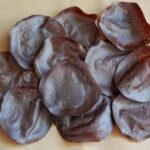


Aspic is a dish in which ingredients are set into a gelatin made from a meat stock Non-savory dishes, often made with commercial gelatin mixes without stock or consommé, are usually called gelatin salads.
Aspic can be used to protect food from the air, to give food more flavor, or as a decoration.
There are three types of aspic textures:
delicate, sliceable, and inedible.
The delicate aspic is soft. The sliceable aspic must be made in a terrine or in an aspic mold. It is firmer than the delicate aspic. The inedible aspic is never for consumption. It is usually for decoration

Aspic is a savory jelly typically made from meat stock that has been boiled long enough to release natural gelatin. Cooks have been using aspics as a means of preserving meats for centuries, but most modern recipes have their roots in French cuisine. The dish can be prepared as a mold, as a garnish, and as a glaze. It is notoriously challenging and sometimes smelly to work with, leading some cooks to avoid it — or at least simplify the cooking process by adding prepared gelatin.
How It’s Made
The base of traditional aspic is meat. Though nearly any variety will work, beef, pork, poultry, and fish are the most common. Cooks often use scraps or pieces that would otherwise be considered waste, and cook them slowly to make a dense broth or consommé. The broth is strained and clarified with egg white until it is clear. Depending on the meat used, the broth may be supplemented with a commercial gelatin to complement the natural pectin present.
Ingredients
2 1/2 cups cold, good stock (fish, meat, chicken or vegetable)
· 3 tablespoons dry white wine
· 3 tablespoons dry sherry
· 2 tablespoons red wine vinegar
· 30 g gelatine
· 1/2 teaspoon salt
· 2 egg whites
· Shells from the eggs, washed
Directions
1. Put all the ingredients into a large, clean saucepan and whisk over low heat until the mixture forms a thick froth on the top and starts to come to the boil. Stop whisking immediately and let the mixture rise to the top of the saucepan, taking care not to let it boil over. As soon as it reaches the top, remove the saucepan from the heat and wait for the mixture to subside. Return the pan to the heat and allow the mixture to rise and subside once more in the same way. Repeat the process once more, then set aside for 5 minutes.
2. Meanwhile, scald a large bowl, a sieve and a large piece of muslin or a clean tea towel with boiling water. Drain both bowl and sieve well and wring out the muslin or tea towel. Line the sieve with the piece of muslin, folded double, or the tea towel, and place it over the bowl. Taking care not to break up the froth, pour the aspic jelly carefully into the sieve and leave undisturbed to strain into the bowl. Do not press or squeeze. Cool the aspic and use immediately. Alternatively, it can be refrigerated for up to 24 hours.


